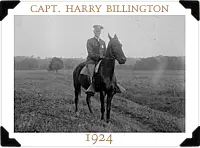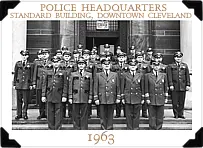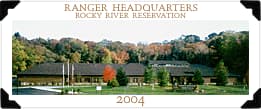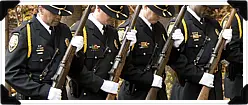
"I want to suggest the advisability of ultimately establishing an outer system of parks and boulevards. Through the valleys of Rocky River on the west, and Chagrin River on the east, lie some of the finest stretches of park lands to be found in northern Ohio. While all of this is now entirely outside the city, it will be but a short time before they will be inside or very near the limits of 'Greater Cleveland,' and it seems to me that they should be secured for the benefit of the entire public before private enterprise or commercial industry places them beyond reach."
William A Stinchcomb
Founder & Future Director,
Cleveland Metropolitan Park District
1905
The Cleveland Metropolitan Park District was established on July 23, 1917. From the beginning days of the Park District, its leaders recognized the need to not only protect the environment, but also those who would visit its pristine surroundings. That need led to the formation of the Cleveland Metropolitan Park District Police Department.
The creation of the Park District's law enforcement agency was made possible on June 14, 1920, when the Board of Park Commissioners passed resolution #315 which called for maintaining "...general peace and good order of the park." The Park District hired its first patrolman on May 5, 1921.
In 1922, a second patrolman was hired, and soon after, the Park District purchased a three room cottage on Lorain Avenue, for $500, to be used as police headquarters. As the year progressed, three more officers joined the ranks at a salary of $100 per month.

The earliest officers patrolled the Park District on foot and horseback, because there were few roads. Officers had no communications equipment. Red illuminated pole lamps were added in key locations throughout the Park District. The lamps were turned on as a simple but effective signal that an incident had occurred which required an officer's attention.
The Great Depression had a significant impact on the Park District. Work programs created by President Franklin D. Roosevelt led to many improvements on park land. By 1933, the Park District and its law enforcement agency were growing in tandem. The department had increased to 15 officers. They used a stable of horses, one motorcycle, and three cars to patrol what had grown, by that year, into a 10,000 acre park district. During World War II, many younger officers were called into service overseas. As a result, older officers were hired to protect the Park District.
"Two years ago...this country had but recently been attacked at Pearl Harbor and had declared war upon the Axis powers. The war has drawn heavily upon the employees of this Board. Practically all young men have left. This has particularly affected our police force. Physical examinations required of candidates for this work are comparable to those of the Army and Navy, and so our young police are the type the war services need."
Willam A. Stinchcomb
Director, Cleveland Metropolitan Park District
1943
In 1945, the Board of Park Commissioners passed resolution #2317, arming its police officers. The .38 caliber Smith & Wesson Police Special was designated as the official department firearm. Prior to the passage of the resolution, officers were expected to furnish their own weapons. In the mid 1950s, the patrol fleet was equipped with mobile telephones instead of standard police radios. It was believed that mobile phones permitted greater flexibility. Chief James K. Hoy reported, "the Park District is adjacent to so many other police districts that no single radio frequency could be assigned satisfactorily."

In 1967, the title "police" was officially changed to "ranger." The department was now called the Cleveland Metroparks Ranger Department. The new name more accurately represented the department's outdoor law enforcement functions. The revamped department soon moved into a new home, occupying a former Ohio Turnpike tollgate building in Strongsville. At the same time, 10 new cars were purchased for the 45 member department. The new vehicles were equipped with the department's first radio system, and a central dispatch center became operational.
The Cleveland Metroparks Ranger Training Academy was also established in 1967. The training academy was the first such center for police and park law enforcement training in the United States, except for the National Park Service Academy in Colorado. Law enforcement officers from other park districts and local police agencies were invited to attend at no cost. During its 19 years of operation, the academy graduated 877 law enforcement officers.
"Signs of progress are evident in the newly organized Ranger Department...Society today is ever-changing. An awareness of forces which can help or hinder the safety of the citizens of our community is necessary for all those whose duty it is to be responsible for the public welfare."
The Emerald Necklace Newsletter
1967
In 1970, while the nation was dealing with the Vietnam War and recovering from the turbulent 60s, Cleveland Metroparks rangers dealt with social unrest on their soil. An autumn concert in Mill Stream Run Reservation erupted into violence. The resulting chaos netted more than 400 arrests. The disturbance remains, to this day, the single largest policing incident for the Cleveland Metroparks Ranger Department.
In 1973 and 1981, national acclaim was bestowed on the Ranger Department.The Mounted Unit was invited to ride in the Washington D.C. inaugural parades of presidents Richard M. Nixon and Ronald W. Reagan. On both occasions, Cleveland Metroparks Ranger Department was selected as the lone Ohio law enforcement representative.
In a profession that is sworn to provide for public safety, rangers are sometimes placed into perilous situations. Such was the case in 1983, when Ranger James English was shot by a man while working undercover at Memphis Picnic Area. Ranger English recovered and returned to work, and was promoted to sergeant shortly thereafter. The department survived a similar occurrence in the late 1970s, when Ranger Paul Moricz was shot through his campaign hat during a traffic stop in Rocky River Reservation. Fortunately, Ranger Moricz was not injured.
By the mid 1980s, the Park District had grown to over 18,000 acres of land, patrolled by 77 rangers. In the years that followed, the Ranger Department became more specialized and technologically advanced. Detective units and K-9 units were established, and a computer-aided dispatch center and records management system were implemented.
In 2004, the department moved into a new headquarters in Rocky River Reservation. Cleveland Metroparks Rangers Headquarters houses prisoner holding facilities, a forensic laboratory, and a museum. The museum displays photographs, uniforms, artifacts, and equipment utilized throughout the years. Of particular note is the national award for Best Dressed Law Enforcement Agency, as featured in the September 2004 edition of Law and Order magazine.

In 2019, in honor of the centennial of the founding Cleveland Metropolitan Park District Police Department the title "ranger" was officially changed back to "police". The department is now called the Cleveland Metroparks Police Department. In 2020, the department badge was redesigned to honor the original patch of the 1920s. Today, the department's force includes over 85 sworn officers. These police patrol what has become a park district with over 25,000 acres of land in six northeast Ohio counties, 100 miles of connecting parkways, and Cleveland Metroparks Zoo.

From its earliest days, Cleveland Metroparks Police Department has grown in size, technology, and experience of its personnel. Through extensive training programs, continuing education efforts, and advancements in technology, the department and its officers remain in a perpetual state of evolution. The vitality of the Police Department reflects the importance the community places on Cleveland's "Emerald Necklace," an open space of natural beauty and diversity that welcomes over 40 million visitors a year.
